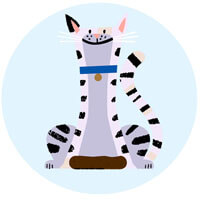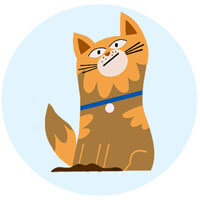Aside from being something you have to clean up from the litter tray, your cat’s poo can provide clues about her overall health. Here, Petplan vet Brian Faulkner reveals the different appearances that your pet’s faeces can take – and what each could indicate. If any abnormal symptoms or signs continue for more than a couple of days, it’s always worth paying a visit to your vet to get your cat checked out.

The perfect poop
The ideal shape for pieces of cat poo is small, compact and oblong, although the length and amount generally correlates with the size of your cat. It should be dark brown in colour and, texture-wise, ‘look for formed and firm, but not hard,’ says Brian.
Adult cats should pass stools once or twice a day, whilst kittens may do so several times over the same period.

Straining to defecate
There are two types of poo your cat might pass, which could indicate constipation: small, hard, dry pieces of faeces, or longer, thin pieces of poo. There can be a range of causes behind constipation, including blockage from hairballs as a result of too much grooming, diet, dehydration or colon problems.
However, although straining to poop can be a sign of constipation, it’s important to ensure this symptom isn’t mistaken for an alternate issue. ‘Sometimes it can appear as though your cat is having trouble defecating, but they’re actually struggling to urinate,’ reveals Brian. ‘This is much more common than constipation, especially in males. Older cats, too, can struggle with passing stools as their bowel loses its tone and the ability to “wring out” the poop – often due to a condition called megacolon.’

Diarrhoea
‘In veterinary terms, we define this as an abnormal poop that’s less solid or viscous than the “ideal” stool,’ explains Brian. ‘Owners sometimes assume that it isn’t diarrhoea unless it’s like water, which isn’t the case. If it’s of a yoghurt-y consistency, or like a mousse, then this would be classed as diarrhoea.’
It can range in colour, too. ‘Diarrhoea can be anything from bright yellow or orange to brown, black or red,’ Brian says. The condition is usually nothing to be too concerned about, and often passes in a couple of days. However, if it lasts longer or is ‘tomato soup-like in appearance, then it is something that needs to be urgently seen to by the vet,’ he adds.
The most common cause of sudden onset diarrhoea in cats is a result of something they’ve eaten that has upset its stomach. ‘Younger cats in particular are more prone to infectious parasites than can lead to softer stools,’ reveals Brian. ‘Dietary intolerances can also be a cause.’

Smell
The odour of healthy cat poo should be mild and barely noticeable. Smelly faeces is usually a sign of an issue in the stomach or intestines – caused by a digestive disorder or parasites to bacteria and poor diet. ‘There’s also a distinctive metallic smell that results from digested blood,’ says Brian.
‘A bad smell alone isn’t anything to be too concerned about. It’s when it appears alongside other symptoms, such as a change in colour or consistency, that the scent often becomes more noticeable and is potentially indicative of a problem,’ he adds.

Foreign objects
Sometimes you might notice odd-looking things in your cat’s poop – ‘everything from bone and string to wood,’ reveals Brian. ‘It’s thought that 80 to 90 percent of foreign bodies will pass through the intestine uneventfully. Though, occasionally, they can cause a blockage.’
Noticing fur in your cat’s poo is nothing to be overly worried about as, when not regurgitated as a furball, the hair they ingest from grooming passes through their system and comes back out with their stools. However, little white flecks resembling grains of rice are usually remnants of tapeworm (although sometimes these can be harder to spot), and should be queried with your vet.

Unusual colours
As already mentioned, colour can be a useful indicator of a problem. Black, red or very dark brown poo is a ‘sign of digested blood,’ Brian states. ‘Your cat might have licked a wound, or just given birth – and the poo would change colour for that reason. It can also be a sign of intestinal bleeding or ulcerations, but this is relatively rare.’
Faeces can also appear in several other colours, from yellow to green to white. ‘But I’ve stopped being surprised by the range of colours cat poop can come in,’ says Brian. ‘A vet can’t look at the shade of poop and automatically diagnose which condition is causing it, as the colour alone rarely tells us anything specific.
It’s a case of playing detective by looking at all the different clues together. Owners have an important role to play in getting accustomed to what’s normal for their cat, and letting their vet know if they have any cause for concern.’